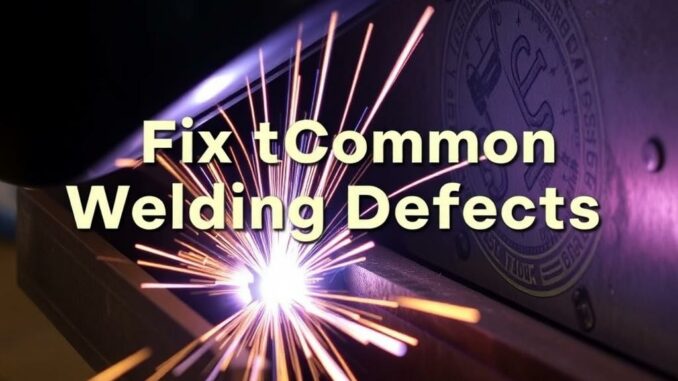
SQLITE NOT INSTALLED
Welding is an essential skill in countless industries — from automotive to construction, aerospace to manufacturing. But even the most experienced welders can encounter defects that compromise the strength, appearance, and longevity of their welds. Among the most common and frustrating welding defects are porosity, cracks, and undercut. Not only do these flaws weaken the joint, but they can lead to costly reworks, failed inspections, and dangerous structural failures.
If you’ve ever dealt with these issues, you understand how vital it is to identify the root causes and apply effective fixes that prevent recurrence. This article dives deep into understanding why porosity, cracks, and undercut happen and provides practical, step-by-step methods to repair and avoid them in future welds. Whether you’re a beginner eager to learn or a seasoned welder looking to refine your technique, this comprehensive guide offers valuable insights and solutions.
Understanding Common Welding Defects
Before we delve into how to fix these problems, it helps to have a clear picture of what each defect is and why it matters. While welding defects can range widely, porosity, cracks, and undercut are three of the most prevalent and stubborn issues.
What is Porosity?
Porosity refers to the presence of small gas pockets or voids trapped within the weld metal. These tiny holes look like little bubbles or pinholes and can be scattered throughout the weld bead, undermining its density and structural integrity. Porosity often leads to weakened joints and can reduce corrosion resistance, making it a serious concern for any welder.
Porosity can range from tiny micropores invisible to the naked eye to larger, more obvious gas pockets. The extent of porosity directly affects the strength and appearance of the weld, which is why addressing this defect is crucial.
What Causes Porosity?
The root causes of porosity are primarily related to gas contamination during the welding process. Moisture, oil, rust, mill scale, or any contaminants on the metal surface or filler materials release gases when heated, which get trapped and form pores. Inadequate shielding gas coverage or improper welding parameters also allow atmospheric gases like oxygen and nitrogen to enter the molten weld pool, increasing porosity.
What are Welding Cracks?
Cracks are another serious defect characterized by fractures in the weld metal or adjacent base metal. These gaps can be microscopic or visible lines and significantly reduce the strength of the welded joint. Cracks can be transverse (across the weld), longitudinal (along the weld), or crater cracks at the end of the weld bead.
Cracks are particularly dangerous because they tend to propagate over time under stress, leading to catastrophic failure if left unaddressed.
Why Do Cracks Occur?
Cracking results from various causes related to thermal stresses and metallurgical transformations during cooling. Rapid cooling rates, excessive restraint from fixtures, high carbon content, hydrogen embrittlement, or improper welding sequence can create internal stresses that exceed the metal’s strength, causing it to crack.
What is Undercut?
Undercut is a groove or channel melted into the base metal along the edges of the weld bead, leaving the metal thinner in this area. It appears as a concave depression adjacent to the weld and weakens the joint by reducing the effective cross-sectional thickness at the weld toe.
While it may seem purely cosmetic, undercut can be a major source of stress concentration, increasing the risk of failure under load or fatigue conditions.
Causes of Undercut
Undercut is typically caused by using excessive welding current, incorrect torch angles, or moving too fast during the welding process. Inappropriate filler metal size and poor technique also contribute to this defect.
How to Fix Porosity in Welding
Since porosity directly affects weld quality, it’s critical to identify the cause before attempting a repair. Here are effective steps to fix porosity issues and prevent them moving forward.
Step 1: Thoroughly Clean the Workpiece
Ensure all surfaces to be welded are meticulously cleaned. Remove any rust, oil, paint, dirt, mill scale, or moisture. Use wire brushes, grinding wheels, or solvents as necessary. Even minute amounts of contaminants can release gases that cause porosity.
Step 2: Check Your Shielding Gas Supply
Make sure the cylinders are full, the regulators are functioning, and gas flow rates adhere to manufacturer recommendations. Too low a flow rate may allow atmospheric air to intrude, while too high a flow can cause turbulence and draw in contaminants.
Step 3: Use Proper Welding Parameters
Incorrect amperage or voltage settings can cause turbulence in the weld pool, trapping gas pockets. Follow your welding procedure specifications and adjust machine settings based on material thickness and joint design.
Step 4: Select Appropriate Filler Material and Electrodes
Use clean, dry filler materials stored properly to avoid moisture pick-up. For stick welding, bake electrodes per specifications. For MIG or TIG welding, always use fresh spools and regularly inspect your wire feeder system.
Step 5: Repairing Existing Porosity Defects
If porosity exists in a completed weld, repair involves grinding out the affected areas until you reach solid metal free of defects. Then re-weld the joint under ideal conditions based on the steps above.
Summary Table: Common Causes of Porosity and Fixes
| Cause of Porosity | How to Fix |
|---|---|
| Contaminants (oil, rust, moisture) | Clean surfaces thoroughly before welding |
| Improper shielding gas flow | Check gas flow rate and equipment integrity |
| Wet or dirty filler materials | Use dry, stored materials; bake electrodes if needed |
| Wrong welding parameters | Adjust amperage/voltage according to specs |
How to Fix Cracks in Welds

Cracks represent a potentially critical defect that must be repaired correctly to guarantee the safety and reliability of welded structures. Understanding crack types and causes is essential before performing repairs.
Step 1: Identify the Type of Crack
Not all cracks are the same. First, perform visual inspections and, if possible, non-destructive testing (NDT) such as dye penetrant, ultrasonic, or radiography to determine crack size, location, and depth. Common crack types include hot cracks (during solidification), cold cracks (after cooling), and fatigue cracks (from repeated stress).
Step 2: Remove the Crack by Grinding
Grind out the crack completely to sound metal. This may require cutting a “V” groove along the crack length to ensure full removal. Undercutting should be avoided during grinding to prevent further weakening.
Step 3: Preheat the Base Metal if Necessary
For materials prone to cracking like high-carbon steels or thick sections, preheating reduces thermal gradients and residual stresses. Preheat temperatures depend on the material but typically range between 100°C to 300°C.
Step 4: Apply Controlled Welding Technique
Use low hydrogen consumables or shielding gases if applicable, and maintain moderate heat input. Multiple small passes may be preferable to a single large one to manage heat buildup and reduce stress.
Step 5: Post-Weld Heat Treatment
Heat treatment after welding relieves residual stresses and reduces the risk of crack formation and propagation. Normalizing, tempering, or stress relieving should be performed according to the material specification.
Step 6: Inspect Your Repairs
After welding and any heat treatment, carefully inspect the repaired zone using visual and NDT methods to ensure cracks have been fully eliminated.
Checklist: Preventing Welding Cracks
- Choose correct welding procedure based on material properties
- Preheat thick or crack-prone materials
- Use low hydrogen electrodes and store them properly
- Control heat input and interpass temperatures
- Allow gradual cooling after welding
- Apply proper joint design minimizing restraint
How to Fix Undercut in Welds
Undercut may seem like just a surface flaw, but it can seriously affect weld strength and durability. Fortunately, avoiding and correcting undercuts is relatively straightforward once you master fundamental welding techniques.
Step 1: Identify Undercut Location and Extent
Visual inspection is usually sufficient to detect undercut. It appears as a groove or notch adjacent to the weld bead, often at the toe of the weld.
Step 2: Modify Welding Technique
Most undercuts arise from excessive heat or incorrect torch angle. The following corrective actions help avoid undercut:
- Reduce welding current or amperage to appropriate levels.
- Maintain proper torch angle—usually between 10° to 15° from vertical.
- Use correct travel speed—not too fast to cause improper fusion and not too slow to overheat.
- Select proper electrode or wire diameter for the joint thickness.
Step 3: Repair Existing Undercut
If an undercut is already present, you can repair it by filling the groove with additional weld metal. Here’s how:
- Grind the undercut edge gently to create a clean surface that the new weld can bond to.
- Use a small electrode to carefully fill the groove with weld metal, ensuring fusion with base material.
- Avoid excessive heat input to prevent re-creating undercut during filling.
- Allow the repair to cool gradually.
Step 4: Final Inspection
After the repair, inspect the weld visually and, if necessary, use non-destructive testing to ensure the repair is solid and free of defects.
Common Causes and Fixes for Undercut: A Quick Reference
| Cause | Fix |
|---|---|
| Excessive welding current | Reduce amperage and follow recommended settings |
| Incorrect torch angle | Use proper 10-15° angle in the direction of travel |
| Fast travel speed | Slow down travel speed to allow proper fusion |
| Inappropriate electrode size | Choose electrode dimension matching material thickness |
Advanced Tips to Avoid Welding Defects
While we’ve covered the basics above, experienced welders know that preventing defects is much easier than repairing them. Here are some advanced tips to promote flawless welds every time.
Maintain Your Equipment
Regular maintenance of welding machines, regulators, hoses, and wire feeders ensures proper function and consistent output. Replace worn nozzles and damaged cables promptly.
Proper Joint Preparation
Good fit-up with uniform root gaps, beveled edges, and properly cleaned surfaces can dramatically reduce residual stresses and defects.
Follow Qualified Welding Procedures
Always work within established welding procedure specifications (WPS) tailored to the metal type, thickness, and joint design. Deviating from these guidelines dramatically increases defect risks.
Use Appropriate Welding Technique
Incorporate stringer beads instead of weaving where possible, control the heat input, and avoid excessive weaving or weaving too quickly.
Control the Environment
Shield weld areas from wind and drafts to prevent shielding gas disruption. Use curtains or screens if necessary.
Train Continuously
Welding is both art and science and requires continuous skill development. Attend workshops, practice different welds, and review defect causes and fixes regularly.
Summary and Key Takeaways
Welding defects like porosity, cracks, and undercut can seem daunting but are manageable with knowledge, technique, and attention to detail. Here’s a quick recap of strategies to fix and prevent these common issues:
- Porosity: Keep surfaces clean, ensure proper gas shielding, use correct parameters and materials, and grind out defective welds to re-weld.
- Cracks: Identify crack type, remove damaged metal, preheat if necessary, use low hydrogen consumables, control heat input, and apply post-weld heat treatment.
- Undercut: Adjust current, torch angle, and travel speed; choose the right electrode size; and fill existing grooves with weld metal after grinding.
With these approaches, you can improve weld quality, increase safety, and extend the life of your welded structures. Remember, welding defects are a natural part of learning and perfecting this craft — the key is to address them proactively, turning every challenge into an opportunity to become a better welder.
Additional Resources for Welders
For those looking to deepen their understanding or troubleshoot specific problems, here are some recommended resources and references:
- American Welding Society (AWS) – Comprehensive guides, certifications, and technical resources.
- Welding Professionals Network – Forums and articles from experienced welders worldwide.
- Welding Tips and Tricks – Practical tutorials and equipment reviews.
- The Welding Institute (TWI) – Research papers and industry standards.
By continuously learning and applying best practices, you can master welding techniques and overcome defects such as porosity, cracks, and undercut, safeguarding the integrity of your projects and materials.
Happy welding!
